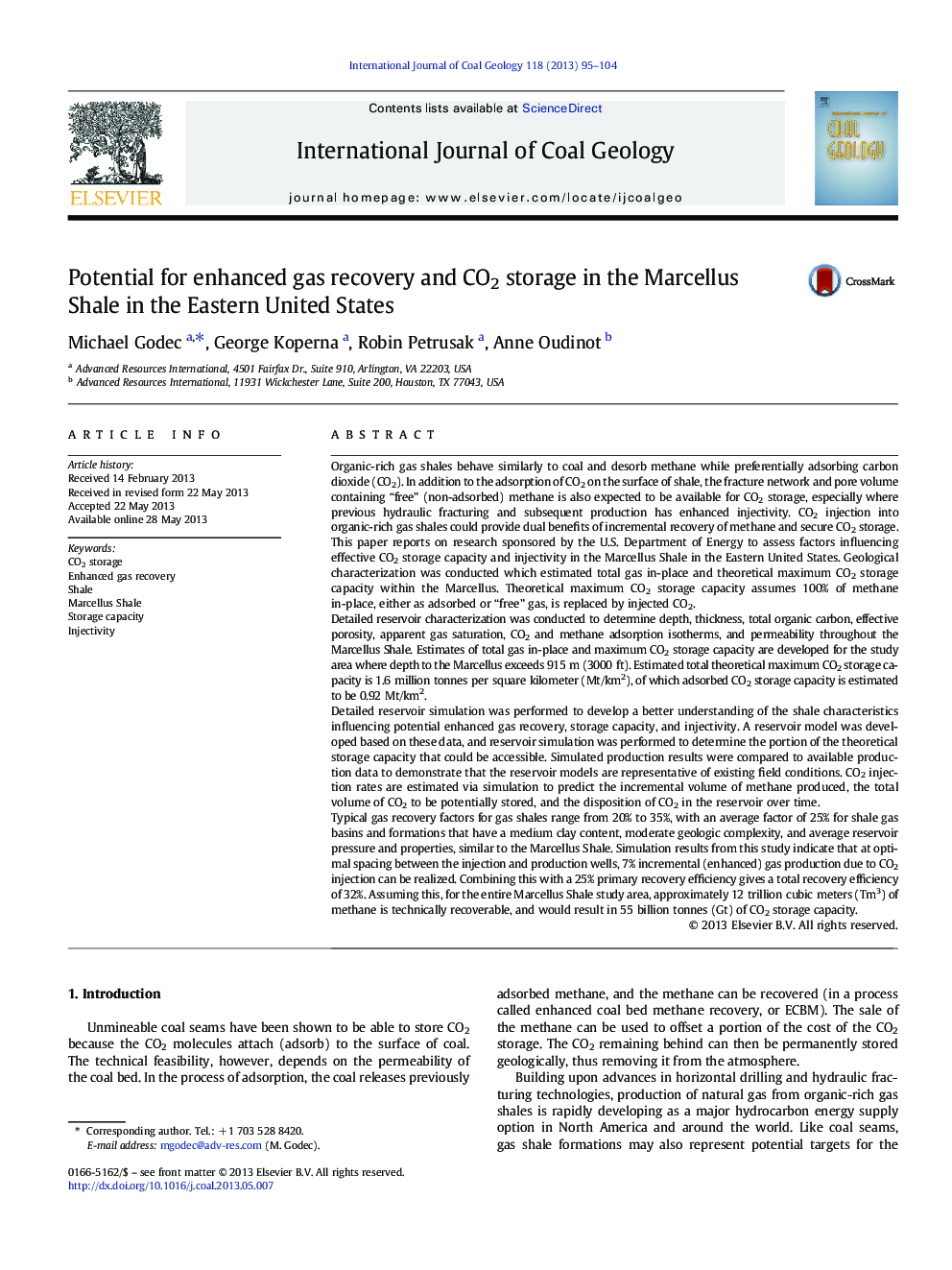| کد مقاله | کد نشریه | سال انتشار | مقاله انگلیسی | نسخه تمام متن |
|---|---|---|---|---|
| 1753334 | 1522578 | 2013 | 10 صفحه PDF | دانلود رایگان |

• Gas shales, like coal, desorb methane while preferentially adsorbing CO2.
• CO2 injection into shales offers incremental gas production and secure CO2 storage.
• Maximum CO2 storage in Marcellus Shale is 1.12 million tonnes/square kilometer.
• For Marcellus, 31 trillion cubic meters of methane could be technically recoverable.
• As much as 52 billion tonnes of CO2 could be stored in the Marcellus Shale.
Organic-rich gas shales behave similarly to coal and desorb methane while preferentially adsorbing carbon dioxide (CO2). In addition to the adsorption of CO2 on the surface of shale, the fracture network and pore volume containing “free” (non-adsorbed) methane is also expected to be available for CO2 storage, especially where previous hydraulic fracturing and subsequent production has enhanced injectivity. CO2 injection into organic-rich gas shales could provide dual benefits of incremental recovery of methane and secure CO2 storage.This paper reports on research sponsored by the U.S. Department of Energy to assess factors influencing effective CO2 storage capacity and injectivity in the Marcellus Shale in the Eastern United States. Geological characterization was conducted which estimated total gas in-place and theoretical maximum CO2 storage capacity within the Marcellus. Theoretical maximum CO2 storage capacity assumes 100% of methane in-place, either as adsorbed or “free” gas, is replaced by injected CO2.Detailed reservoir characterization was conducted to determine depth, thickness, total organic carbon, effective porosity, apparent gas saturation, CO2 and methane adsorption isotherms, and permeability throughout the Marcellus Shale. Estimates of total gas in-place and maximum CO2 storage capacity are developed for the study area where depth to the Marcellus exceeds 915 m (3000 ft). Estimated total theoretical maximum CO2 storage capacity is 1.6 million tonnes per square kilometer (Mt/km2), of which adsorbed CO2 storage capacity is estimated to be 0.92 Mt/km2.Detailed reservoir simulation was performed to develop a better understanding of the shale characteristics influencing potential enhanced gas recovery, storage capacity, and injectivity. A reservoir model was developed based on these data, and reservoir simulation was performed to determine the portion of the theoretical storage capacity that could be accessible. Simulated production results were compared to available production data to demonstrate that the reservoir models are representative of existing field conditions. CO2 injection rates are estimated via simulation to predict the incremental volume of methane produced, the total volume of CO2 to be potentially stored, and the disposition of CO2 in the reservoir over time.Typical gas recovery factors for gas shales range from 20% to 35%, with an average factor of 25% for shale gas basins and formations that have a medium clay content, moderate geologic complexity, and average reservoir pressure and properties, similar to the Marcellus Shale. Simulation results from this study indicate that at optimal spacing between the injection and production wells, 7% incremental (enhanced) gas production due to CO2 injection can be realized. Combining this with a 25% primary recovery efficiency gives a total recovery efficiency of 32%. Assuming this, for the entire Marcellus Shale study area, approximately 12 trillion cubic meters (Tm3) of methane is technically recoverable, and would result in 55 billion tonnes (Gt) of CO2 storage capacity.
Journal: International Journal of Coal Geology - Volume 118, 1 October 2013, Pages 95–104